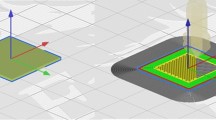Abstract
Printed electronics such as solar cells, RFIDs, and display panels can be made using printed electronic technology by printing viscous liquids having various properties on films or insulating substrates. Among printed electronic production processes, the roll-to-roll process transfers functional ink to an insulation substrate by filling its engravings through repeated contact and rotation of two rolls. Extensive research has been conducted to commercialize this process because it offers several advantages such as low equipment investment and production cost, and high-speed mass production. However, the roll-to-roll process requires further development for commercialization because print quality precision and fine pattern formation are difficult to achieve, and print quality may be affected by processing precision errors and non-uniform printing pressure. Contact printing pressure is the pressure acting on the nip that makes contact with the two rolls, and is a factor that influences roll processing precision. That is, contact printing pressure uniformity must be maintained to enhance print quality. However, previous research on contact printing pressure failed to directly estimate the contact printing pressure due to structural problems, and only indirectly measured it by attaching a load cell at both ends of the impression roll. This study proposes a method of contact printing pressure estimation and control to enhance print quality. The processing precision of a roll can be measured by measuring the rotationally repeatable run-out after dividing the width of the impression roll and plate roll into 25 points. The relationship between the impression roll and the plate roll, with consideration of the contact printing pressure, rotationally repeatable run-out, and force measured by the load cell, is modeled in a manner similar to the relationship between a car body, suspension, and ground in a half-car model, and expressed using state-space equations. This model is then applied to an individual drive type cross-coupled control system for experiments on control of the contact printing pressure; pressure measuring films are used to check for actual improvement in uniformity of contact printing pressure.















Similar content being viewed by others
References
Gandhi P, Adarsh S, Ramachandran K (2017) Performance analysis of half car suspension model with 4 DOF using PID, LQR, FUZZY and ANFIS controllers. Proc Comput Sci 115:2–13
Jung E, Kim SJ, Cho SM (2017) Production technology status of organic lighting and display via roll-to-roll process. Kor Vac Soc 4:24–28
Jung M, Kim H, Oh D (2015) Lateral position measurement system for precision alignment of roll-to-roll printing using alignment patterns and quantity of light. Trans Korean Soc Mech Eng A 39(9):879–884
Kim H, Oh D, Kim Y, Kim T, Kim J (2015) Run-out compensation to maintain uniform printing pressure in the roll-to-roll printed electronics, Jeju Island, pp 896–897
Kim Y, Kim M, Kim T, Kim J, Oh D (2018) Printing pressure uniformization of a roll-to-roll system using roll runout. Microsyst Technol 24:4561–4568
Kim J, Kim Y, Kim T, Lee B, Oh D (2019) A pressure control to compensate measurement delay in roll-to-roll process. Trans Korean Soc Mech Eng A 43(2):139–143
Kim J, Kim Y, Kim T, Lee B, Park J, Oh D (2020) Printing pressure uniformization through adaptive feedforward control in roll-to-roll printing process. Microsyst Technol 26:265–273
Sun D, Shao X, Feng G (2007) A model-free cross-coupled control for position synchronization of multi-axis motions: theory and experiments. IEEE/ASME Trans Mech 7(1):306–314
Yeh S, Hsu P (2002) Estimation of the contouring error vector for the cross-coupled control design. IEEE/ASME Trans Mech 7(1):44–51
Acknowledgments
This work was supported by research fund of Chungnam National University.
Author information
Authors and Affiliations
Corresponding author
Additional information
Publisher's Note
Springer Nature remains neutral with regard to jurisdictional claims in published maps and institutional affiliations.
Rights and permissions
About this article
Cite this article
Park, J., Kim, Y., Kim, H. et al. Contact printing pressure uniformization in roll-to-roll process using individual drive cross-coupled torque control. Microsyst Technol 27, 2515–2522 (2021). https://doi.org/10.1007/s00542-021-05213-4
Received:
Accepted:
Published:
Issue Date:
DOI: https://doi.org/10.1007/s00542-021-05213-4




